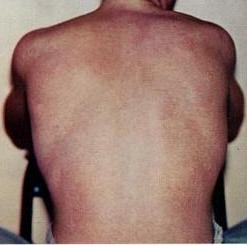Dengue fever physical examination: Difference between revisions
(→HEENT) |
|||
| Line 23: | Line 23: | ||
==Mental Status== | ==Mental Status== | ||
[[Lethargy]] and [[restlessness]] are warning signs that the patient should be monitored. | [[Lethargy]] and [[restlessness]] are warning signs that the patient should be monitored for the development of severe disease. | ||
==HEENT== | ==HEENT== | ||
Revision as of 20:16, 14 June 2014
|
Dengue Fever Microchapters |
|
Diagnosis |
|---|
|
Treatment |
|
Case Studies |
|
Dengue fever physical examination On the Web |
|
American Roentgen Ray Society Images of Dengue fever physical examination |
|
Risk calculators and risk factors for Dengue fever physical examination |
Editor-In-Chief: C. Michael Gibson, M.S., M.D. [1]
Overview
The classic picture of Dengue Fever includes a high fever with no localizing source of infection on physical examination, with petechia being present occasionally. The physical examination in Dengue fever should be directed toward identifying signs that the patient has severe disease warranting admission or in-hospital observation.
Vital Signs
Pulse and Blood Pressure
Tachycardia, postural hypotension, a narrow pulse pressure (<20 mm Hg) and / or frank hypotension could indicate intravascular volume depletion due to either dehydration or capillary leak. The presence of any of the above is a warning sign of severe disease, and the patient should be hospitalized for observation.
Urine Output
Patients who are triaged to home management should urinate at least every 6 hours.
Skin
If the patient has poor perfusion, the skin may be cold and clammy.
Petechiae may be present. The tourniquet test can used to cause petechia.
-
The above picture is a rash typically associated with Dengue fever.
Mental Status
Lethargy and restlessness are warning signs that the patient should be monitored for the development of severe disease.
HEENT
Mucosal bleeding is a warning signs that the patient may have thrombocytopenia, and should be monitored for the development of severe disease.
Lungs
- Pleural effusion is a warning sign the capillary leak may be occurring and that the patient should be monitored.
Abdomen
- Abdominal pain or tenderness are warning signs that the patient should be monitored.
- Liver enlargment >2 cm is a warning signs that the patient should be monitored.
- Ascites is a warning signs that the patient should be monitored.
Extremities
- Pedal edema or evidence of fluid accumulation
